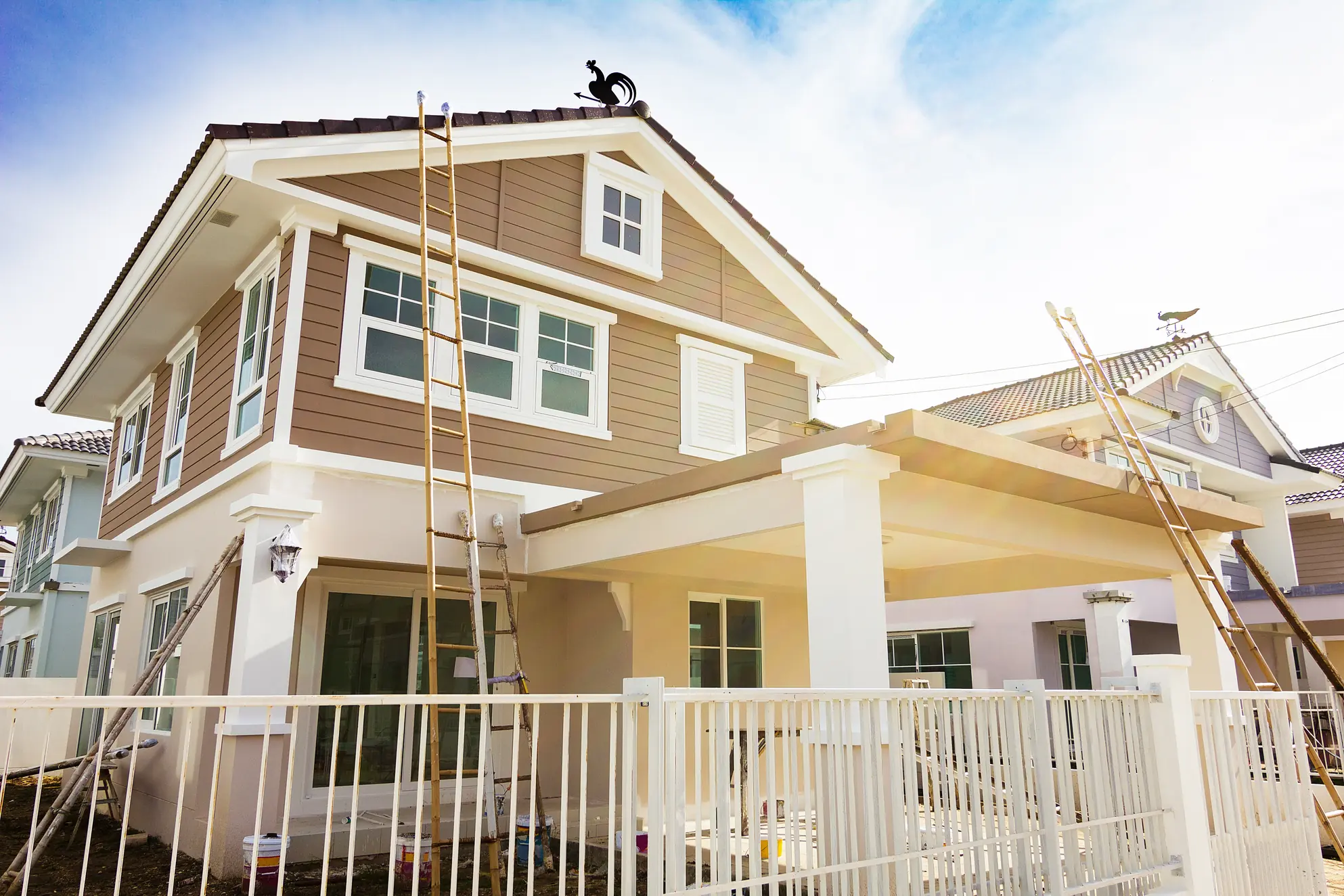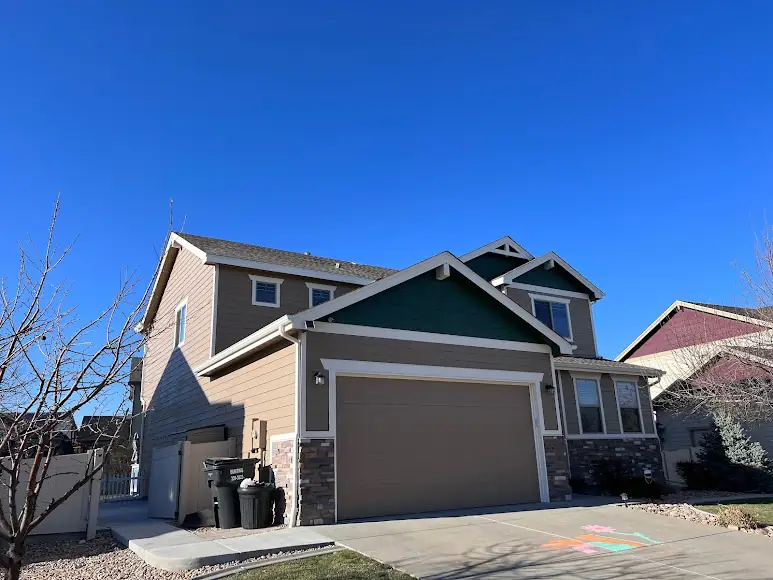Choosing the right painter in Estes Park means finding someone who understands Colorado's unique climate challenges and delivers lasting results.
Share:

Summary:
In Estes Park, summers are comfortable while winters are freezing, snowy, and windy, with temperatures typically varying from 12°F to 77°F. That’s not just weather trivia—it’s critical information that affects every painting decision.
Add in hailstorms, temperature swings, and freeze-thaw cycles, and you’ve got a recipe for paint failure without proper preparation and materials. The painters who last in this market understand these challenges and adjust their approach accordingly. The ones who don’t? You’ll be calling them back within two years—or worse, calling someone else to fix their work.

We always talk about UV protection before we talk about color. Colorado’s intense UV exposure, temperature swings, and harsh weather require premium weather-resistant coatings that resist fading, chalking, and cracking in high-altitude environments.
Quality painting companies carefully plan projects around the weather, taking measures to protect surfaces during rain or snow and ensuring paint is applied under optimal conditions. This isn’t just good practice—it’s the difference between a paint job that survives Colorado winters and one that starts peeling by spring.
We explain why we choose specific products for Colorado conditions. We schedule projects during optimal weather windows and use premium materials designed specifically for high-altitude, high-UV environments. If your painter isn’t discussing these factors upfront, they’re missing something crucial about working in this climate.
The months from June to September are most favorable for exterior painting in Estes Park, with comfortable temperatures of 68.5°F to 72.5°F and reduced precipitation. Professional painters know this window and plan their schedules around optimal conditions rather than just when it’s convenient.
One of the biggest mistakes homeowners encounter is skipping or rushing surface preparation, as excitement about colors often overshadows the critical prep work that ensures a durable paint job. This is where you’ll see the biggest difference between professional painters and those cutting corners.
Professional preparation means more than just slapping primer on the wall. Pressure washing surfaces before painting removes dirt, mold, and loose paint, helping new paint stick better and last longer, while fixing cracks or holes gives you a smoother final look. This step alone can add years to your paint job’s lifespan.
Every quality exterior painting project includes comprehensive surface preparation, premium weather-resistant coatings, and complete cleanup, with power washing, scraping, sanding, and priming to ensure proper paint adhesion and longevity. We spend 60% of our time on prep and 40% painting to deliver results that last twice as long as someone who reverses those percentages.
We know prep work is half the job, and you cannot paint over dust, peeling old paint, or glossy finishes and expect it to look good or last. When a painter explains their prep process in detail, you’re hearing from someone who understands what creates lasting results.
Want live answers?
Connect with a LF Rosa Painting expert for fast, friendly support.
Always get three to five estimates, always use insured contractors, and remember that a long business history helps you avoid shoddy companies since it’s hard for a service business to stay in business if they don’t do good work. This isn’t just good advice—it’s your protection against headaches and unexpected costs.
Never use a painter who isn’t willing to put their work in writing. That’s non-negotiable. Quality painters stand behind their work with clear contracts, detailed scopes, and satisfaction guarantees because we’re confident in our results.

The right questions reveal everything about a painter’s experience and approach. Ask “How long have you been in business?” because a long business history helps you avoid shoddy companies—it’s hard for a service business to stay in business if they don’t do good work. In Estes Park’s tight-knit community, word spreads quickly about quality work and poor results.
Ask “Are you licensed and insured?” Not all states require licenses for painting homes, but many do, and you should always use one that’s insured. This protects you from liability if something goes wrong and shows the painter treats their business professionally.
Ask “Do you have other work I can look at?” Always check a portfolio, and in the case of painters, it’s better to look at work they did a few years ago to see how well it’s held up. Recent work looks impressive—but how does it perform after facing Colorado’s temperature extremes and UV exposure?
Ask specifically about their experience with Colorado conditions. Because of the weather extremes in Northern Colorado, it’s important to have a painting service company that can address these unique needs. We discuss UV-resistant coatings, primer selection, and weather timing without you having to ask.
Be cautious of contractors requiring large down payments—you might need to make a down payment, usually 25% to 50% of the total project cost to cover material costs, but don’t pay for the entire project upfront. Legitimate painters don’t need your money to buy materials—we have established credit with suppliers.
Watch out for painters who barely mention surface preparation. One of the most common mistakes painters make is not preparing the surface properly, as painting over dust, dirt, or uneven surfaces results in patchy finish and poor adhesion. If prep work isn’t a major part of their proposal, they’re planning to skip the most important step.
Red flags include vague estimates without material specifications, no proof of insurance, pressure for immediate decisions, or reluctance to provide local references from the past two years. Quality contractors take a walk around your home to evaluate current paint condition, job size, and access obstacles to see how much prep work they’ll need—the more thorough the inspection, the more accurate the quote.
Be especially wary of painters who don’t ask about timing or weather considerations. Timing matters for exterior house painting, with the best time in Colorado usually during warmer parts of the year when temperature stays above 50°F. We plan around optimal conditions, not just our availability.
When selecting a painter for your property in Estes Park, consider their approach to the work, as understanding these details contributes to a better overall outcome. The right painter combines local knowledge, climate-appropriate materials, and proven processes that deliver results lasting years, not months.
Quality painters in the Estes Park area understand that using paints designed to withstand Colorado weather conditions helps maintain appearance longer, ultimately saving you money through fewer repaints. We discuss specific product choices and explain exactly why certain materials perform better at altitude and in intense UV conditions.
Your investment in professional painting pays off when you choose a painter who understands these local challenges and has the track record to prove it. For painting services that protect your Estes Park property against Colorado’s demanding climate, contact L F Rosa Painting to discuss your project with experienced professionals who get it right the first time.
Article details:
Share:
Continue learning: